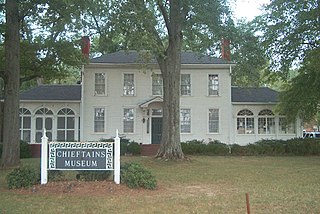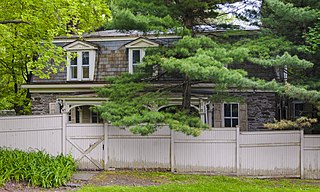
The Emily Dickinson Museum is a historic house museum consisting of two houses: the Dickinson Homestead and the Evergreens. The Dickinson Homestead was the birthplace and home from 1855–1886 of 19th-century American poet Emily Dickinson (1830–1886), whose poems were discovered in her bedroom there after her death. The house next door, called the Evergreens, was built by the poet's father, Edward Dickinson, in 1856 as a wedding present for her brother Austin. Located in Amherst, Massachusetts, the houses are preserved as a single museum and are open to the public on guided tours.

Chieftains Museum, also known as the Major Ridge Home, is a two-story white frame house built around a log house of 1792 in Cherokee country. It was the home of the Cherokee leader Major Ridge. He was notable for his role in negotiating and signing the Treaty of New Echota of 1835, which ceded the remainder of Cherokee lands in the Southeast to the United States. He was part of a minority group known as the Treaty Party, who believed that relocation was inevitable and wanted to negotiate the best deal with the United States for their people.

There are 69 properties listed on the National Register of Historic Places in Albany, New York, United States. Six are additionally designated as National Historic Landmarks (NHLs), the most of any city in the state after New York City. Another 14 are historic districts, for which 20 of the listings are also contributing properties. Two properties, both buildings, that had been listed in the past but have since been demolished have been delisted; one building that is also no longer extant remains listed.

Samuel Rich House is a historic home located at Penfield in Monroe County, New York. It was originally built in 1816 as a 1 1⁄2-story, gable-roofed frame dwelling in the rural vernacular building tradition. It was substantially enlarged in 1832 with the addition of an elegant 2-story, five-bay, Federal style, hipped roof, main block. Also on the property are three contributing structures: a chicken coop, brick smokehouse, and the stone foundation of a frame barn.

Evergreen Acres is a historic home and farm complex located at Cazenovia in Madison County, New York. The frame farmhouse was built about 1814 in the Federal style and enlarged and altered about 1860. Also on the property are a barn, carriage house, two corn cribs, a silo, and two hen houses.

Crandall Farm Complex is a historic home and farm complex located at Cazenovia in Madison County, New York. The frame farmhouse was built about 1870 and is a two-story, frame residence in the vernacular Italianate style. Also on the property are two barns, carriage house, privy, shed, and cobblestone well house.

Sweetland Farmhouse is a historic farmhouse located at Cazenovia in Madison County, New York. It was built about 1825 and is a 1 1⁄2-story, rectangular, frame residence with a gable roof and in the Federal style. Also on the property is a garage, shed, and chicken house.

Rolling Ridge Farm is a historic home and farm complex located at Cazenovia in Madison County, New York. The farmhouse was built about 1837 and is a two-story, rectangular, brick residence with a gable roof and in the Federal style. Also on the property are two frame barns and a carriage house converted to gallery space.

Tall Pines is a historic home located at Cazenovia in Madison County, New York. The main block of the house was built about 1835 and is a two-story, three-bay, rectangular, frame building in the Federal style. A wing was added to it in stages during the 19th and early 20th centuries. Also on the property is a guest house.

Cobblestone House is a historic home located at Cazenovia, New York in Madison County, New York. It is a cobblestone building built in the Greek Revival style about 1840. It consists of a 2-story main block flanked by a 1 1⁄2-story service wing. It is built of coursed rounded stones set in mortar. Also on the property is a contributing carriage house.

The William H. Moore House, also known as the Stokes-Moore Mansion and once home to the America-Israel Cultural Foundation, is a historic building located in New York, New York. The building was designed by the architecture firm McKim, Mead & White and built between 1898 and 1900. It is a five-story, rectangular stone building in the Renaissance Revival style. It has an English basement and flat roof with balustrade and overhanging cornice. It was commissioned by William Earle Dodge Stokes (1852–1926), and purchased by financier William Henry Moore (1848-1923) before its completion. His wife resided in the house until her death in 1955, after which it housed a succession of commercial and charitable organizations, including the Banco di Napoli.

House at 176 Prospect Avenue is a historic home located at Sea Cliff in Nassau County, New York. It was built in 1886 and is a 2 1⁄2-story, clapboard residence with a cross-gable, slate-covered roof in the Queen Anne style. It features a 3-story square tower with a hipped roof and board and batten cornice.

9 Locust Place is a historic house located at the address of the same name in Sea Cliff, Nassau County, New York.

House at 195 Prospect Avenue is a historic home located at Sea Cliff in Nassau County, New York. It was built about 1890 and is a two-story house with decorative slate jerkinhead roof in the Late Victorian style. It features a three-bay shed-roof dormer that forms the second floor and covers the entrance porch. It is identical to the House at 199 Prospect Avenue.

House at 362 Sea Cliff Avenue is a historic home located at Sea Cliff in Nassau County, New York. It was built about 1875 and expanded in 1890. It consists of a three-bay, 2-story main section with a mansard roof and 1 1⁄2-story gable-roofed wing in the Second Empire style. It features a shed-roofed porch with scrollsawn corner brackets.

House at 58 Eighteenth Avenue is a historic home located at Sea Cliff in Nassau County, New York. It was built in 1893 and is a two-story, three bay clapboard sided residence with a cross gable roof in the Late Victorian style. It features a first floor porch with spindle balustrade and fishscale shingling. Also on the property is a contributing cast iron fence.

Heermance House and Law Office is a historic home located at Rhinecliff, Dutchess County, New York. Located on the property is a cottage, built about 1858 in the Picturesque Italianate style; the Gothic-inspired law office building, built about 1886; and a garage, built about 1900. The house is a two-story, three bay building with a broad picturesque verandah, ornamental brackets, and pierced woodwork. It has a long, two story, gable roofed rear wing. The law office building is a small, one story frame structure sheathed in clapboard.

Mansakenning is a historic home located at Rhinebeck, Dutchess County, New York. It was built about 1903 and is a Georgian-inspired manor house. It is a rectangular, two to three story stone dwelling with a hipped roof and built into a hillside. The five bay wide building features a hipped roof entrance porch supported by paired Doric order columns. Also on the property are a contributing barn, carriage house, two sheds, and a guest cottage.

The Jan Pier House is a historic home located at Rhinebeck, Dutchess County, New York. The farmhouse was built about 1761 and remodeled about 1881 in a Second Empire style. It is a one- to two story, asymmetrical stone building built into a hillside. It features a Mansard roof sheathed in polychrome slate. Also on the property are two contributing barns, a smoke house, wellhouse / well, and a cistern.

La Casina is a historic commercial building located in Jamaica, Queens. New York City. It was originally built about 1907 and completely redesigned about 1936 in the Streamline Moderne style. It is a one-story building designed for use as a nightclub. It has a streamlined facade in the form of a stepped pyramid or ziggurat. The building retains its original vertical neon sign. From the 1940s through 1987, the building housed a clothing factory.

















